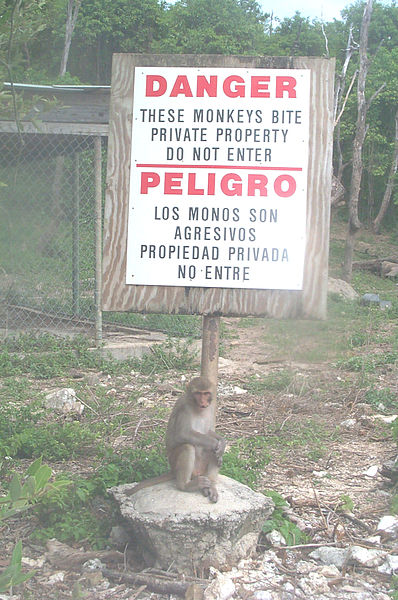Dan Lewis continues to provide us with interesting facts.
Cayo Santiago is a small island about half a mile off the southeast coast of Puerto Rico. Shaped like an upside down L, the island is only about 140,000 square meters in area and has a population of zero.
Unless you count the 900 or so monkeys living there, that is. (And apparently, they bite.)
In 1938, a team of researchers relocated 409 Rhesus monkeys from India, hoping to build a wilderness preserve for them so that Western scientists could study the monkeys in something akin to their natural habitat. Nearly seventy-five years later, the experiment continues, successfully. Accounts vary, but there are currently between 850 and 950 monkeys, all descended from those imported in 1938, living in the wild on Cayo Santiago — now, colloquially, also referred to as “Monkey Island.”
Roughly a dozen researchers from mainland Puerto Rico visit the island daily, observing and interacting with the army of primates in hopes of gathering data and gleaning insight into their society. Some researchers — ethologists — observe the monkeys, staying out of sight if possible. But others look to interact with Cayo Santiago’s residents. One of these researchers, Laurie Santos, is an evolutionary psychologist from Yale University. Her studies focus on the something called “theory of mind” — how humans can infer what others are thinking based on their behavior, even if the people (or animals) being observed are not speaking. For example, our body language and facial expressions send signals which most other people can rely upon to figure out, with typically solid accuracy, what is going on in our brains. That skill, Santos believes, developed somewhere along the way, and the Cayo Santiago monkeys may have unique value. As she told Smithsonian magazine, ”if you see something in a primate, you can use it as a window into the evolutionary past of human beings.” Being able to interact with a large number of monkeys has led Santos to conclude that “the gap between human and animal cognition, even a chimpanzee, is greater than the gap between a chimp and a beetle.”
That cognitive gap probably explains why Monkey Island is closed to tourists. The monkeys can be vicious, lacking even the most basic regard for human visitors. Even the researchers need to take caution while visiting, eating their lunches in a chain-link fence-enclosed area to prevent the animals from stealing a snack. And as the sign above suggests, the primates are not ones to give much thought as to what they stick their teeth into.
